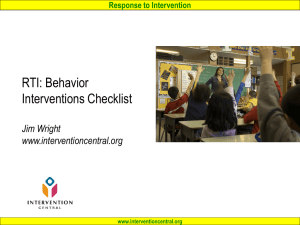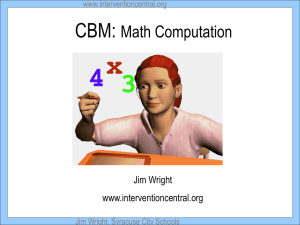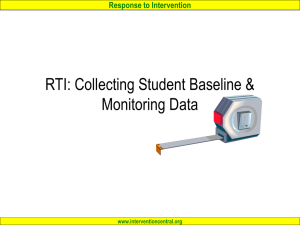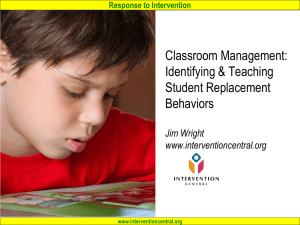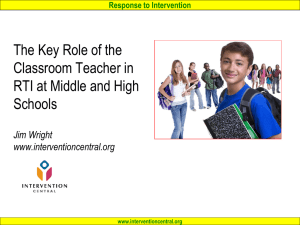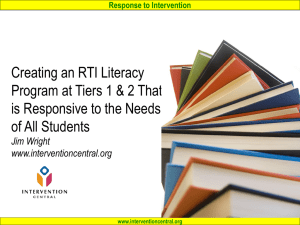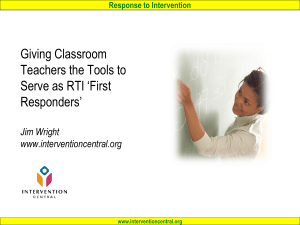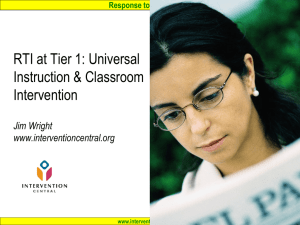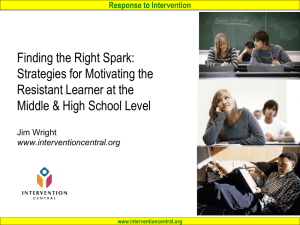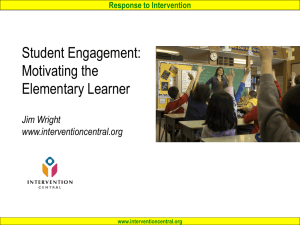RTI_assess_CBM_intro..
advertisement
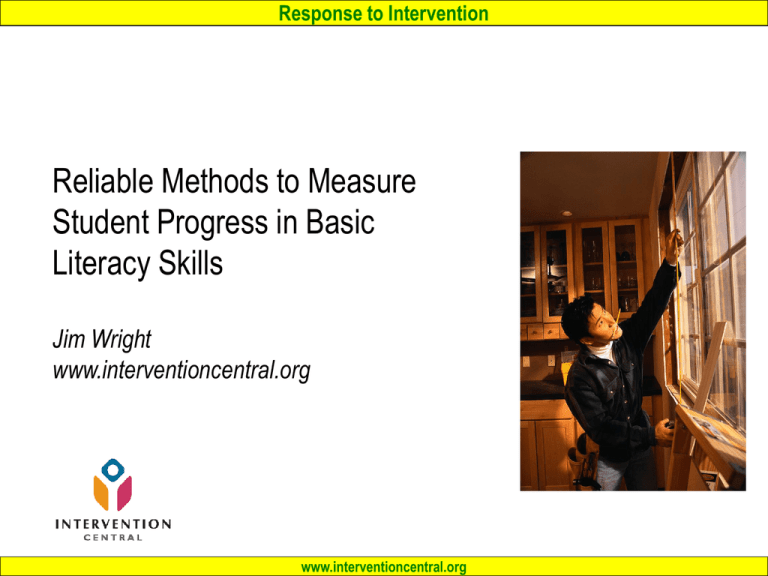
Response to Intervention Reliable Methods to Measure Student Progress in Basic Literacy Skills Jim Wright www.interventioncentral.org www.interventioncentral.org Response to Intervention Monitoring Student Academics: Curriculum-Based Measurement www.interventioncentral.org Response to Intervention Models in Reading & Math 5 Strands of Mathematical Proficiency 5 Big Ideas in Beginning Reading 1. Understanding 1. Phonemic Awareness 2. Computing 2. Alphabetic Principle 3. Applying 3. Fluency with Text 4. Reasoning 4. Vocabulary 5. Engagement 5. Comprehension Source: Big ideas in beginning reading. Source: National Research Council. (2002). Helping University of Oregon. Retrieved September 23, children learn mathematics. Mathematics Learning Study 2007, from http://reading.uoregon.edu/index.php Committee, J. Kilpatrick & J. Swafford, Editors, Center for Education, Division of Behavioral and Social Sciences and Education. Washington, DC: National Academy Press. www.interventioncentral.org 3 Response to Intervention Curriculum-Based Evaluation: Definition • • • • “Whereas standardized commercial achievement tests measure broad curriculum areas and/or skills, CBE measures specific skills that are presently being taught in the classroom, usually in basic skills. Several approaches to CBE have been developed. Four common characteristics exist across these models: The measurement procedures assess students directly using the materials in which they are being instructed. This involves sampling items from the curriculum. Administration of each measure is generally brief in duration (typically 1-5 mins.) The design is structured such that frequent and repeated measurement is possible and measures are sensitive to change. Data are usually displayed graphically to allow monitoring of student performance.” SOURCE: CAST Website: http://www.cast.org/publications/ncac/ncac_curriculumbe.html www.interventioncentral.org 4 Response to Intervention SOURCE: CAST Website: http://www.cast.org/publications/ncac/ncac_curriculumbe.html www.interventioncentral.org Response to Intervention Curriculum-Based Measurement: Advantages as a Set of Tools to Monitor RTI/Academic Cases • Aligns with curriculum-goals and materials • Is reliable and valid (has ‘technical adequacy’) • Is criterion-referenced: sets specific performance levels for specific tasks • Uses standard procedures to prepare materials, administer, and score • Samples student performance to give objective, observable ‘lowinference’ information about student performance • Has decision rules to help educators to interpret student data and make appropriate instructional decisions • Is efficient to implement in schools (e.g., training can be done quickly; the measures are brief and feasible for classrooms, etc.) • Provides data that can be converted into visual displays for ease of communication Source: Hosp, M.K., Hosp, J. L., & Howell, K. W. (2007). The ABCs of CBM. New York: Guilford. www.interventioncentral.org 6 Response to Intervention Standards for Judging Academic Measures for RTI (National Center for Student Progress Monitoring) www.interventioncentral.org 7 Response to Intervention RTI : Assessment & Progress-Monitoring • • • To measure student ‘response to instruction/intervention’ effectively, the RTI Literacy model measures students’ reading performance and progress on schedules matched to each student’s risk profile and intervention Tier membership. Benchmarking/Universal Screening. All children in a grade level are assessed at least 3 times per year on a common collection of literacy assessments. Strategic Monitoring. Students placed in Tier 2 (supplemental) reading groups are assessed 1-2 times per month to gauge their progress with this intervention. Intensive Monitoring. Students who participate in an intensive, individualized Tier 3 reading intervention are assessed at least once per week. Source: Burns, M. K., & Gibbons, K. A. (2008). Implementing response-to-intervention in elementary and secondary schools: Procedures to assure scientific-based practices. New York: Routledge. www.interventioncentral.org 8 Response to Intervention Example of Curriculum-Based Assessment Reading Probe www.interventioncentral.org Response to Intervention DIBELS Reading Probe: Benchmark 2.1 www.interventioncentral.org Response to Intervention www.interventioncentral.org 11 Response to Intervention 57 WPM www.interventioncentral.org 12 Response to Intervention CBM Student Reading Samples: What Difference Does Fluency Make? • 3rd Grade: 19 Words Per Minute • 3rd Grade: 70 Words Per Minute • 3rd Grade: 98 Words Per Minute www.interventioncentral.org 13 Response to Intervention Evaluating the ‘RTI Readiness’ of School Assessments Jim Wright www.interventioncentral.org www.interventioncentral.org Response to Intervention www.interventioncentral.org 15 Response to Intervention Interpreting the Results of This Survey… • YES to Items 1-3. Background. The measure gives valid general information about the student’s academic skills and performance. While not sufficient, the data can be interpreted as part of a larger collection of student data. • YES to Items 4-5. Baseline. The measure gives reliable results when given by different people and at different times of the day or week. Therefore, the measure can be used to collect a current ‘snapshot’ of the student’s academic skills prior to starting an intervention. • YES to Items 6-7. Goal-Setting. The measure includes standards (e.g., benchmarks or performance criteria) for ‘typical’ student performance (e.g., at a given grade level) and guidelines for estimating rates of student progress. Schools can use the measure to assess the gap in performance between a student and grade level peers—and also to estimate expected rates of student progress during an intervention. • YES to Items 8-11. Progress Monitoring. The measure has the appropriate qualities to be used to track student progress in response to an intervention. www.interventioncentral.org 16 Response to Intervention Background: Validity • Content Validity. Does the measure provide meaningful information about the academic skill of interest? • Convergent Validity. Does the measure yield results that are generally consistent with other well-regarded tests designed to measure the same academic skill? • Predictive Validity. Does the measure predict student success on an important future test, task, or other outcome? www.interventioncentral.org 17 Response to Intervention Baseline: Reliability • Test-Retest/Alternate-Form Reliability. Does the measure have more than one version or form? If two alternate, functionally equivalent versions of the measure are administered to the student, does the student perform about the same on both? • Interrater Reliability. When two different evaluators observe the same student’s performance and independently use the measure to rate that performance, do they come up with similar ratings? www.interventioncentral.org 18 Response to Intervention Benchmarks & Goal-Setting • Performance Benchmarks. Does the measure include benchmarks or other performance criteria that indicate typical or expected student performance in the academic skill? • Goal-Setting. Does the measure include guidelines for setting specific goals for improvement? www.interventioncentral.org 19 Response to Intervention Progress-Monitoring and Instructional Impact • Repeated Assessments. Does the measure have sufficient alternative forms to assess the student weekly for at least 20 weeks? • Equivalent Alternate Forms. Are the measure’s repeated assessments (alternative forms) equivalent in content and level of difficulty? • Sensitive to Short-Term Student Gains. Is the measure sensitive to short-term improvements in student academic performance? • Positive Impact on Learning. Does research show that the measure gives teachers information that helps them to make instructional decisions that positively impact student learning? www.interventioncentral.org 20 Response to Intervention Team Activity: Evaluating the ‘RTI Readiness’ of School Assessments At your table: • Review the handout Evaluate the RTI Readiness of Your School’s Academic Measures. • Discuss how your school or district might use such a form to evaluate common classroom academic measures. www.interventioncentral.org 21 Response to Intervention Curriculum-Based Measurement Tools for Reading Skills www.interventioncentral.org Response to Intervention Reading: Phonemic Awareness / Alphabetics Initial Sound Fluency : 3 minutes Administration: 1:1 Description: The student is shown 4 pictures, each depicting an object that begins with a different letter sound. The examiner gives the student a letter sound and asks the student to select the picture of the object that begins with that letter sound. The process is repeated with new sets of pictures until the time Where to get materials: DIBELS https://dibels.uoregon.edu/ www.interventioncentral.org 23 Response to Intervention Reading: Phonemic Awareness / Alphabetics Phoneme Segmentation Fluency 1 minute Administration: 1:1 Description: The student is read a list of words that contain from 2 to five phonemes. For each word, the student is asked to recite all of the phonemes that make up the word. Where to get materials: DIBELS https://dibels.uoregon.edu/ www.interventioncentral.org 24 Response to Intervention Reading: Phonemic Awareness / Alphabetics Nonsense Word Fluency 1 minute Administration: 1:1 Description: The student is shown a list of nonsense words of 2 to 3 letters in length. For each word, the student is to read the word or give the sounds that make up the word. Where to get materials: DIBELS https://dibels.uoregon.edu/ www.interventioncentral.org 25 Response to Intervention Reading: Phonemic Awareness / Alphabetics Letter Naming Fluency 1 minute Administration: 1:1 Description: The student is presented with a list of randomly arranged letters. The student names as many letters as possible. Where to get materials: DIBELS https://dibels.uoregon.edu/ www.interventioncentral.org 26 Response to Intervention Reading: Phonemic Awareness / Alphabetics Letter Sound Fluency 1 minute Administration: 1:1 Description: The student is presented with a list of randomly arranged letters. The student gives the sounds of as many letters as possible. Where to get materials: www.interventioncentral.org www.interventioncentral.org 27 Response to Intervention Reading: Phonemic Awareness / Alphabetics Word Identification Fluency 1 minute Administration: 1:1 Description: The student is presented with a list of words randomly selected from a larger word list (e.g., Dolch Wordlist). The student reads as many words as possible. Where to get materials: Easy CBM http://www.easycbm.com Intervention Central http://www.interventioncentral.org (Dolch wordlists) www.interventioncentral.org 28 Response to Intervention Reading: Fluency Oral Reading Fluency : 1 minute Administration: 1:1 Description: The student reads aloud from a passage and is scored for fluency and accuracy. Passages are controlled for level of reading difficulty. Where to get materials: DIBELS https://dibels.uoregon.edu/ AimsWeb http://www.aimsweb.com/ Easy CBM http://www.easycbm.com Intervention Central http://www.interventioncentral.org (Use the OKAPI page to create customized ORF passages) www.interventioncentral.org 29 Response to Intervention Reading: Basic Comprehension Maze Passages : 1-3 minutes Administration: Group Description: The student is given a passage in which every 7th word has been removed. The student reads the passage silently. Each time the student comes to a removed word, the student chooses from among 3 replacement words: the correct word and two distractors. The student circles the replacement word that he or she believes best restores the meaning of the text. Where to get materials: AimsWeb http://www.aimsweb.com/ Intervention Central http://www.interventioncentral.org (Use the Maze Passage Generator page to create customized Maze passages) www.interventioncentral.org 30 Response to Intervention Reading: Basic Comprehension Multiple-Choice Reading Comprehension : Unknown Administration: Group Description: The student is given a passage to read. The student then answers a series of standardized comprehension questions based on the text. Where to get materials: Easy CBM http://www.easycbm.com www.interventioncentral.org 31 Response to Intervention Example: Using Local Reading Norms in Coordination with Research Norms www.interventioncentral.org Response to Intervention Baylor Elementary School : Grade Norms: Correctly Read Words Per Min : Sample Size: 23 Students Group Norms: Correctly Read Words Per Min: Book 4-1: Raw Data 31 34 34 39 41 43 52 55 59 61 68 71 74 75 85 89 102 108 112 115 118 118 131 LOCAL NORMS EXAMPLE: Twenty-three 4th-grade students were administered oral reading fluency Curriculum-Based Measurement passages at the 4th-grade level in their school. In their current number form, these data are not easy to interpret. So the school converts them into a visual display—a boxplot —to show the distribution of scores and to convert the scores to percentile form. When Billy, a struggling reader, is screened in CBM reading fluency, he shows a SIGNIFICANT skill gap when compared to his grade peers. www.interventioncentral.org 33 Response to Intervention Baylor Elementary School : Grade Norms: Correctly Read Words Per Min : Sample Size: 23 Students January Benchmarking Group Norms: Correctly Read Words Per Min: Book 4-1: Raw Data 31 34 34 39 41 43 52 55 59 61 68 71 74 75 85 89 102 108 112 115 118 118 131 National Reading Norms: 112 CRW Per Min Group Norms: Converted to Box-Plot Median (2nd Quartile)=71 1st Quartile=43 3rd Quartile=108 Billy=19 Hi Value=131 Low Value=31 0 20 40 Source: Tindal, G., Hansbrouck, J., & Jones, C. (2005).Oral reading fluency: 90 years of measurement [Technical report #33]. Eugene, OR: University of Oregon. 60 80 100 120 140 160 Correctly Read Words-Book 4-1 www.interventioncentral.org 34
